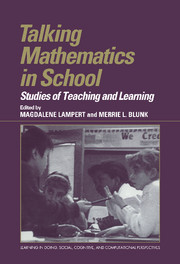Part I - Doing and Learning Mathematical Talk
Published online by Cambridge University Press: 04 August 2010
Summary
We begin this volume with an overview of the domain by Mary Catherine O'Connor investigating what might be meant by doing and learning mathematical “discourse” in school. O'Connor considers mathematics as a “practice” with its own norms for doing and talking, and she looks at how these norms might differ from those children learn in families and with peers. O'Connor considers a variety of “protoforms” of mathematical talk that are found in children's out-of-school speech behaviors. From this perspective, she raises fundamental questions about the transfer of capacities developed in the context of informal talk at home to mathematical work in school. O'Connor's analysis suggests several reasons why students who are able to argue and reason and use appropriate quantitative words at home might have difficulty importing these abilities into the social setting of the classroom. Her review provides a backdrop for research on what and how children need to learn if they are to “talk mathematics” in school. These questions are taken up in the rest of the studies in this book.
Chapters 3 and 4 are complementary analyses of the ways in which students do and do not connect mathematical talk with talk about actions on objects. Kay McClain and Paul Cobb draw on theories of mathematical learning and development to observe that the scenarios within which students work on school problems (i.e., the “stories” in story problems) make a significant difference in their capacity to make meaningful mathematical moves.
- Type
- Chapter
- Information
- Talking Mathematics in SchoolStudies of Teaching and Learning, pp. 15 - 16Publisher: Cambridge University PressPrint publication year: 1998



